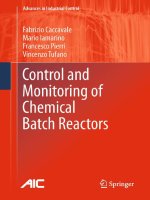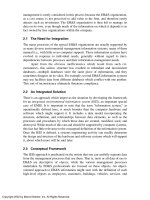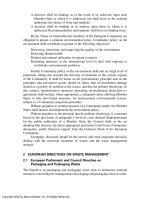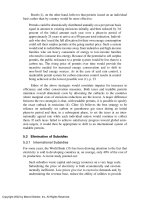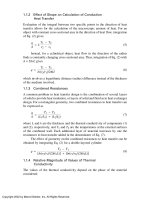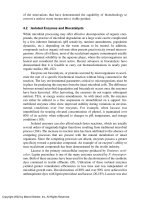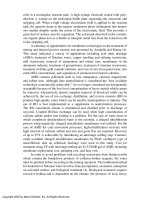Data based methods for modeling, control and monitoring of chemical processes
Bạn đang xem bản rút gọn của tài liệu. Xem và tải ngay bản đầy đủ của tài liệu tại đây (4 MB, 223 trang )
DATA-BASED METHODS FOR MODELING, CONTROL
AND MONITORING OF CHEMICAL PROCESSES
CHENG CHENG
NATIONAL UNIVERSITY OF SINGAPORE
2006
DATA-BASED METHODS FOR MODELING, CONTROL AND
MONITORING OF CHEMICAL PROCESSES
CHENG CHENG
(B. Eng., ECUST, China)
(M. Eng., ECUST, China)
A THESIS SUBMITTED
FOR THE DEGREE OF DOCTOR OF PHILOSOPHY
DEPARTMENT OF CHEMICAL AND BIOMOLECULAR ENGINEERING
NATIONAL UNIVERSITY OF SINGAPORE
2006
ACKNOWLEDGEMENTS
I would like to express my deepest gratitude to my research supervisor, Dr.
Min-Sen, Chiu for this excellent guidance and valuable ideas. I am indebted to him
for providing me advices not only in the academic research but also my daily life. My
special thanks to Dr. Chiu for his invaluable time for reading and revising this
manuscript.
I am also thankful to Dr. Rangaiah, Dr. Lakshminarayanan, and Dr Wang
Qing-Guo for their valuable advices to my research work. Special thanks and
appreciation are due to Zhuang Hualiang, Ye Myint Hlaing, Yasuki Kansha, and
Ankush Kalmukale for the stimulating discussions that we have had and the help that
they have rendered to me. I would like to express my special words of gratitude to Mr.
Jimmy Goh for understanding and providing me support when I worked as a part time
student in NUS. I would also wish to thank Ms Tay Choon Yen, Mdm Fam Hwee
Koong, Mdm Khoh Leng Khim, and Mdm Siew Woon Chee for the efficient and
prompt help. I am also indebted to the National University of Singapore for providing
me the excellent research facilities and research scholarships.
I cannot find any words to thank my hubby and my parents for their
unconditional support, affection and encouragement, without which this research
work would not have been possible.
i
TABLE OF CONTENTS
ACKNOWLEDGEMENTS
i
TABLE OF CONTENTS
ii
SUMMARY
vi
NOMENCLATURE
ix
LIST OF FIGURES
xii
xviii
LIST OF TABLES
CHAPTER 1. INTRODUCTION
1
1.1 Motivations
1
1.2 Contributions
3
1.3 Thesis Organization
5
CHAPTER 2. LITERATURE REVIEW
7
2.1 Nonlinear Process Modeling
7
2.1.1 Standard-learning methods
8
2.1.2 Just-in-time learning
14
2.2 Controller Design for Nonlinear Processes
16
2.2.1 Robust control
17
2.2.2 Adaptive control
21
2.2.3 Nonlinear internal model control (NIMC)
25
2.3 Process Monitoring
28
2.3.1 Data-based methods
28
ii
2.3.2 Model-based methods
30
CHAPTER 3. AN ENHANCED JUST-IN-TIME LEARNING
32
3.1 Introduction
32
3.2 Just-in-time Learning
34
3.3 Enhanced JITL Methodology
37
3.4 Examples
43
3.5 Conclusion
53
CHAPTER 4. ROBUST CONTROLLER DESIGN FOR NONLINEAR
59
PROCESSES USING JITL TECHNIQUE
4.1 Introduction
59
4.2 Modeling Methodology
61
4.3 Robust Stability Analysis
66
4.4 Examples
69
4.5 Conclusion
80
CHAPTER 5. ADAPTIVE SINGLE-NEURON CONTROLLER DESIGN
82
5.1 Introduction
82
5.2 JITL Based Adaptive Single-Neuron Controller Design
85
5.2.1 Control strategy
85
5.2.2 Learning algorithm
86
5.3 Examples
89
5.4 Conclusion
107
iii
CHAPTER 6. ADAPTIVE IMC CONTROLLER DESIGN
108
6.1 Introduction
108
6.2 JITL Based Adaptive IMC Design
110
6.2.1 Linear IMC framework
110
6.2.2 Proposed adaptive IMC controller design
111
6.3 Examples
115
6.4 Conclusion
117
CHAPTER 7. AUTO-TUNING PID CONTROLLER DESIGN
126
7.1 Introduction
126
7.2 Auto-Tuning PID Controller Design
128
7.2.1 Information vector selection
128
7.2.2 Controller design
131
7.3 Examples
135
7.4 Conclusion
140
CHAPTER 8. JITL-PCA BASED PROCESS MONITORING
153
8.1 Introduction
153
8.2 PCA and Model-Based PCA
155
8.3 JITL-PCA for Process Monitoring
157
8.4 Examples
161
8.5 Conclusion
172
CHAPTER 9. CONCLUSIONS AND FURTHER WORK
9.1 Conclusions
184
184
iv
9.2 Suggestions for Further Work
186
REFERENCES
189
PUBLICATIONS AND PRESENTATIONS
202
v
SUMMARY
“Data rich but information poor” is a common problem for most chemical
processes. Therefore, how to extract useful information from data for the purposes of
process modeling, control, and monitoring is one of the challenges in chemical
industries. In this thesis, a new just-in-time learning (JITL) modeling methodology
has been proposed to deal with this problem and the JITL based design methods for
controller design and process monitoring have been developed. The main
contributions of this thesis are as follows.
First, an enhanced JITL methodology is proposed by using both distance
measure and angle measure to evaluate the similarity between two data samples,
which is not exploited in the conventional JITL methods. In addition, parametric
stability constraints are incorporated into the proposed method to address the stability
of local models. Furthermore, a new procedure of selecting the relevant data set is
proposed. Simulation studies illustrate that the proposed method gives marked
improvement over its conventional counterparts in nonlinear process modeling. It is
also demonstrated that the proposed method can be made adaptive online readily by
simply adding the new process data to the database.
Second, based on the enhanced JITL technique, a robust controller design
methodology is proposed for processes with moderate nonlinearity. Assuming that
process nonlinearity is the only source of the model uncertainty, a composite model
consisting of a nominal ARX model and JITL, where the former is used to capture the
linear process dynamics and the latter to approximate the process nonlinearity, is
employed to model the process behaviour in the operating space of interest. The state
space realization of the resulting model is then reformulated as an uncertain system,
by which the robust stability analysis of this uncertain system under PID control is
vi
developed. Literature examples are employed to illustrate that the proposed
methodology can be used to obtain the robust stability region in the parameter space
of a PID controller, which assures the closed-loop stability for controlling the
nonlinear process in the concerned operating space.
Next, by incorporating the JITL into the controller design, three data-based
controller design methods are proposed: adaptive single-neuron (ASN) controller,
adaptive IMC controller, and auto-tuning PID controller. ASN controller uses a single
neuron to mimic the traditional PID controller. The ASN controller can control the
unknown nonlinear dynamic process adaptively through the updating of controller
parameters by the adaptive learning algorithm developed and the information
provided from the JITL. Adaptive IMC controller integrates the JITL into the IMC
framework. The controller parameters are updated not only based on the information
provided by the JITL, but also its filter parameter is adjusted online by an adaptive
learning algorithm. In the auto-tuning PID controller, a controller database is
constructed to store the known PID parameters with their corresponding information
vectors, while another database is employed for the standard use by JITL technique
for modeling purpose. The PID parameters are automatically extracted from controller
database according to the current process dynamics characterized by the information
vector at every sampling instant. Moreover, the PID parameters thus obtained can be
further fine-tuned, whenever necessary, and the resulting updated PID parameters
with their corresponding information vector are stored into the controller database.
These controller design methods exploit the current process information from JITL to
realize online tuning controller parameters for nonlinear process control. Because of
the parsimonious design framework, these adaptive controllers can be implemented
online without heavy computational burden. Simulation results demonstrate that the
vii
proposed controllers give better control performance than their conventional
counterparts.
Last, by integrating JITL and principal component analysis (PCA) into a JITLPCA monitoring scheme, a new monitoring method is proposed for dynamic
nonlinear process. JITL serves as the process observer to account for the nonlinear
dynamic behavior of the process under normal operating conditions. The residuals
resulting from the difference between JITL’s predicted outputs and process outputs
are analyzed by PCA to evaluate the status of the current process operating conditions.
Simulation results show that JITL-PCA gives marked improvement over PCA and
DPCA in the monitoring of nonlinear static or dynamic systems.
viii
NOMENCLATURE
Ai , Bi , C i , Di
State space model parameters
C A , C Af , C B , C C ,
Concentrations
C I , C I in
Initiator concentration
C m , C min
Monomer concentration
di
Distance between x i and x q
Ei , Fi
Model uncertainty part
F , FI
Flow rate
f
Low-pass filter
f*
Parameter of polymerization reaction
G
~
G
~
G−−1
Process
Kd , Ki , K p
Auto-tuning PID controller parameters
K (k )
Auto-tuning PID controller parameter vector
k I , k f m , k p , kTc , kTd
Parameters of polymerization reaction
k1 , k 2 , k 3
Kinetic parameters of van de Vusse reactor
k min , k max
Number of minimum and maximum relevant data sets
L
Level of reactor
l
Number of nearest neighbours
P
Regression matrix
Pk
Principal component loading matrix
Mm
Molecular weight of monomer
Q
Statistical Variable of PCA
r
Set-point
si
Similarity number
T , Ti
Reactor Temperatures
T2
Statistical Variable of PCA
Model of the process
~
Minimum phase of G
ix
u
Process input
V
Reactor volume
W
Weight matrix
w1 , w2 , w3
Parameters of ASN controller
xi , xq
Information and query vector
y
Process output
yl
Output of the nominal ARX model
y nl
Nonlinear effect of process
yˆ
Model prediction
z
Regression vector
Greek Symols
α 1 , α 2 , β1
ARX model parameters
α l ,1 , α l , 2 , β l ,1
Nominal ARX model parameters
γ
JITL algorithm parameter
δ1 , δ 2 , δ 3 , δ a
Model uncertainty
ε
Threshold of auto-tuning PID algorithm
η , ηi
Adaptive learning rate
θi
Angle between ∆x i and ∆x q
κ
Weight factor of objective functions
λ
ρ
IMC filter time constant
σ (k )
Information vector of auto-tuning PID
τI , τD
PID controller parameters
Average density
Abbreviations
ARX
Autoregressive exogenous
CSTR
Continuous stirred tank reactor
DPCA
Dynamic principal component analysis
x
IMC
Internal model control
JITL
Just-in-time learning
MAE
Mean absolute error
MSE
Mean squared error
MIMO
Multi-input multi-output
NN
Neural network
PCA
Principal component analysis
PID
Proportional-integral-derivative
SISO
Single input single-output
xi
LIST OF FIGURES
Figure 2.1
Structure of a multi-layer feedforward network
10
Figure 2.2
Structure of a recurrent neural network
11
Figure 2.3
Comparison of JITL and standard-learning
16
Figure 2.4
The M-∆ structure
19
Figure 2.5
Diagram of adaptive control scheme
21
Figure 3.1
Illustration of angle measure
38
Figure 3.2
Steady-state curve of van de Vusse reactor
44
Figure 3.3
Input-output data used for constructing the database (van
de Vusse reactor)
44
Figure 3.4
Validation result of C B
47
Figure 3.5
Response for step change from 34.3 to 49.3 (top) and 14.3
(bottom) in F
48
Figure 3.6
Response for step change from 34.3 to 55 (top) and 109
(bottom) in F
48
Figure 3.7
Validation result (with noisy process data)
49
Figure 3.8
Input-output data used for constructing the database
(CSTR example)
51
Figure 3.9
Input data used in validation test of CSTR example
53
Figure 3.10
Validation results of L
54
Figure 3.11
Validation results of C A
55
Figure 3.12
Validation results of T
56
Figure 3.13
Validation result (with noisy process data)
57
Figure 3.14
Response when v varies from 0 to 0.25
58
Figure 3.15
Response when v varies from 0 to -0.25
58
Figure 4.1
M-∆ structure for the composite model described by Eqs.
(4.7) and (4.9)
64
xii
Figure 4.2
M-∆ structure for the composite model based on a firstorder ARX model
65
Figure 4.3
M-∆ structure for the uncertain closed-loop system
68
Figure 4.4
Input-output data used for constructing the database for
JITL
70
Figure 4.5
Validation result for the composite model
71
Figure 4.6
Robust stability region (shadow) for van de Vusse reactor
71
Figure 4.7
Closed-loop responses for set-point changes from
C B = 0.7 to 1.0 (top) and 0.4 (bottom) with PI parameters
k c = 31.8 and τ I = 2
72
Figure 4.8
Closed-loop responses for set-point changes from
C B = 0.7 to 1.0 (top) and 0.4 (bottom) with PI parameters
k c = 35.4 and τ I = 4
72
Figure 4.9
Input-output data used for constructing the database for
JITL
74
Figure 4.10
Validation results for nominal ARX model and composite
model
75
Figure 4.11
Robust stability region (shadow) for distillation process
76
Figure 4.12
Closed-loop responses for set-point changes from
y = −0.035 to 0.009 (top) and − 0.08 (bottom) with PI
parameters k c = 1.24 and τ I = 2.5
76
Figure 4.13
Closed-loop responses for set-point changes from
y = −0.035 to 0.009 (top) and − 0.08 (bottom) with PI
parameters k c = 1.32 and τ I = 4
77
Figure 4.14
Robust stability region (shadow) for CSTR process
79
Figure 4.15
Closed-loop responses for set-point changes
x1 = 0.55 to 0.87 (top) and 0.2 (bottom) with PI
parameters k c = 32.4 and τ I = 1.1
from
79
Figure 4.16
Closed-loop responses for set-point changes
x1 = 0.55 to 0.87 (top) and 0.2 (bottom) with PI
parameters k c = 41.4 and τ I = 3
from
80
xiii
Figure 5.1
JITL based ASN control system
85
Figure 5.2
ASN controller
86
Figure 5.3
Polymerization reactor
90
Figure 5.4
Input-output data used for constructing the database for
JITL
92
Figure 5.5
Closed-loop responses for set-point changes to 40000
kg/kmol (top) and 15000 kg/kmol (bottom). Dashed: setpoint; solid: ASN; dashed-dot: IMC
97
Figure 5.6
Updating of ASN parameters for set-point changes to
40000 kg/kmol (top) and 15000 kg/kmol (bottom)
98
Figure 5.7
Closed-loop responses for − 10% (top) and 10% (bottom)
step changes in C I in . Dashed: set-point; solid: ASN;
99
dashed-dot: IMC
Figure 5.8
Closed-loop responses for set-point changes to 40000
kg/mol (top) and 15000 kg/kmol (bottom) under − 10%
modeling error in k I . Dashed: set-point; solid: ASN;
dashed-dot: IMC
100
Figure 5.9
Servo responses in the presence of process noise
101
Figure 5.10
Servo response for the ASN design based on JITL and
recursive least square (RLS) models. Dashed: set-point;
solid: JITL; dashed-dot: RLS
102
Figure 5.11
Closed-loop responses for + 10% (top) and − 50%
(bottom) set-point change. Dashed: set-point; solid: ASN;
dashed-dot: IMC
103
Figure 5.12
Updating of ASN parameters for + 10% (top) and − 50%
(bottom) set-point changes
104
Figure 5.13
Closed-loop responses for − 10% (top) and 10% (bottom)
step disturbances in C Af . Dashed: set-point; solid: ASN;
105
dashed-dot: IMC
Figure 5.14
Closed-loop responses of 10% (top) and − 50% (bottom)
set-point changes under − 10% modeling error in k 3 .
Dashed: set-point; solid: ASN; dashed-dot: IMC
106
Figure 6.1
Block diagram of IMC structure
110
xiv
Figure 6.2
JITL based adaptive IMC scheme
112
Figure 6.3
Closed-loop responses for set-point changes to 40000
kg/kmol (top) and 15000 kg/kmole (bottom). Dashed: setpoint; solid: adaptive IMC; dashed-dot: IMC
118
Figure 6.4
Updating of filter parameters for set-point changes to
40000 kg/kmol (top) and 15000 kg/kmol (bottom)
119
Figure 6.5
Closed-loop responses for − 10% (top) and 10% (bottom)
step disturbances in C I in . Dashed: set-point; solid: adaptive
IMC; dashed-dot: IMC
120
Figure 6.6
Closed-loop responses for set-point changes to 40000
kg/mol (top) and 15000 kg/kmol (bottom) under − 10%
modeling error in k I . Dashed: set-point; solid: adaptive
IMC; dashed-dot: IMC
121
Figure 6.7
Servo responses in the presence of process noise
122
Figure 6.8
Closed-loop responses for + 10% (top) and − 50%
(bottom) set-point changes. Dashed: set-point; solid:
adaptive IMC; dashed-dot: IMC
123
Figure 6.9
Closed-loop responses for − 10% (top) and 10% (bottom)
step disturbances in C Af . Dashed: set-point; solid: adaptive
IMC; dashed-dot: IMC
124
Figure 6.10
Closed-loop responses for 10% (top) and − 50% (bottom)
set-point changes under − 10% modeling error in k 3 .
Dashed: set-point; solid: adaptive IMC; dashed-dot: IMC
125
Figure 7.1
Block diagram of the auto-tuning PID design
129
Figure 7.2
Servo responses of the PID controller for ± 10% set-point
changes. Dashed: set-point; solid: PID
137
Figure 7.3
Data used for constructing the initial controller database
138
Figure 7.4
Closed-loop responses for set-point change to 40000
kg/kmol (top) and − 20% step disturbance in C I in
141
(bottom). Dashed: set-point; solid: the proposed method;
dashed-dot: PID
Figure 7.5
Closed-loop responses for set-point change to 15000
kg/kmol (top) and − 20% step disturbance in C I in
(bottom). Dashed: set-point; solid: the proposed method;
xv
142
dashed-dot: PID
Figure 7.6
Updating of PID parameters for the closed-loop responses
given in Figure 7.4 (top) and Figure 7.5 (bottom)
143
Figure 7.7
Closed-loop responses for set-point changes to 40000
kg/mol (top) and 15000 kg/kmol (bottom) under − 10%
modeling error in k I . Dashed: set-point; solid: the
proposed method; dashed-dot: PID
144
Figure 7.8
Servo responses in the presence of process noise
145
Figure 7.9
Comparison between the proposed design and IMC
controller for set-point changes to 40000 kg/mol (top) and
15000 kg/kmol (bottom). Dashed: set-point; solid: the
proposed method; dashed-dot: IMC
146
Figure 7.10
Servo responses of the PID controller around nominal
operating condition. Dashed: set-point; solid: PID
147
Figure 7.11
Closed-loop responses for 10% set-point change (top) and
− 2% step disturbance in C Af (bottom). Dashed: set-point;
148
solid: the proposed method; dashed-dot: PID
Figure 7.12
Closed-loop responses for − 50% set-point change (top)
and − 20% step disturbance in C Af (bottom). Dashed: setpoint; solid: the proposed method; dashed-dot: PID
149
Figure 7.13
Updating of PID parameters for the closed-loop responses
given in Figure 7.11 (top) and Figure 7.12 (bottom)
150
Figure 7.14
Closed-loop responses for 10% (top) and − 50% (bottom)
set-point changes under − 10% modeling error in k 3 .
Dashed: set-point; solid: the proposed method; dashed-dot:
PID
151
Figure 7.15
Comparison between the proposed design and IMC
controller for 10% (top) and − 50% (bottom) set-point
changes. Dashed: set-point; solid: the proposed method;
dashed-dot: IMC
152
Figure 8.1
Model-based PCA monitoring scheme
157
Figure 8.2
JITL-PCA monitoring scheme
159
Figure 8.3
Modeling result of JITL. (•): actual output; (+): model
output
162
xvi
Figure 8.4
Monitoring result of the fault 1: (a) JITL-PCA; (b) PCA
164
Figure 8.5
Monitoring result of the fault 2: (a) JITL-PCA; (b) PCA
164
Figure 8.6
Monitoring result of JITL-PCA in the new operating space
166
Figure 8.7
Two CSTRs in series with an intermediate feed
167
Figure 8.8
Comparison between FIR model and ARX model under the
fault 1
170
Figure 8.9
Modeling result of JITL under normal condition. Solid
line: actual output; dashed line: model output
173
Figure 8.10
Monitoring result of fault 1: (a) JITL-PCA; (b) DPCA
174
Figure 8.11
Monitoring result of fault 2: (a) JITL-PCA; (b) DPCA
175
Figure 8.12
Monitoring result of fault 3: (a) JITL-PCA; (b) DPCA
176
Figure 8.13
Monitoring result of fault 4: (a) JITL-PCA; (b) DPCA
177
Figure 8.14
Monitoring result of fault 5: (a) JITL-PCA; (b) DPCA
178
Figure 8.15
Monitoring result of fault 6: (a) JITL-PCA; (b) DPCA
179
Figure 8.16
Monitoring result of fault 7: (a) JITL-PCA; (b) DPCA
180
Figure 8.17
Monitoring result of fault 8: (a) JITL-PCA; (b) DPCA
181
Figure 8.18
Monitoring result of fault 9: (a) JITL-PCA; (b) DPCA
182
Figure 8.19
Monitoring result of fault 10: (a) JITL-PCA; (b) DPCA
183
xvii
LIST OF TABLES
Table 3.1
Validation error of the proposed method for various values
of γ
45
Table 3.2
Parameters and nominal values of CSTR example
49
Table 3.3
Validation error of the proposed method for various values
of γ
50
Table 5.1
Model parameters for polymerization reactor
91
Table 5.2
Steady-state operating condition of polymerization reactor
91
Table 5.3
MAEs of two controllers for various set-point changes
94
Table 6.1
MAEs of two controllers for various set-point changes
116
Table 8.1
Summary of JITL-PCA monitoring result in the new
165
operating space
Table 8.2
Parameters of example 2
169
Table 8.3
Fault description for example 2
169
Table 8.4
Monitoring result of JITL-PCA and DPCA for example 2
172
xviii
Chapter 1
Introduction
1.1 Motivations
Thanks to the development of advanced control techniques and computer
technologies, spectacular progresses have been achieved in process control during the
last two decades. However, with the market competition getting more intense than
before, growing demands for improving performance of process still stimulate
researchers to develop more efficient and reliable methods for process modeling,
control and monitoring.
In chemical industries, hundreds or even thousands of variables, such as flow
rate, temperature, pressure, levels and compositions are routinely measured and
automatically recorded in historical databases for the purposes of process control,
online optimization or monitoring. Despite that significant potential benefits may be
gained from the database, it is generally not a trivial task to extract useful information
and knowledge from the databases. Therefore, most chemical processes face a wellknown problem, i.e., “data rich but information poor”. Thus how to extract relevant
1
Chapter 1 Introduction
information from data to better understand process behavior becomes a significant
research topic for chemical industries. On the other hand, an accurate process model
can improve the performance of many advanced control and monitoring methods.
However, model development represents 75% of the cost of developing advanced
process control design (Nelles, 2001). Moreover, for most chemical processes,
detailed first-principle models are often unavailable or too costly and tedious to build.
In this respect, data-based methods capable of extracting the information from process
data for process modeling, control, and monitoring become an attractive alternative.
During last two decades, several data-based methods are proposed for
nonlinear system modeling (Pearson, 1999; Nelles, 2001), for example, artificial
neural network (ANN) and neuro-fuzzy network, Volterra series or other various
orthogonal series models (Nelles, 2001). However, when dealing with large sets of
data, these approaches becomes less attractive because of the difficulties in specifying
model structure and the complexity of the associated optimization problems, which
are usually highly non-convex. Because of these restrictions, most nonlinear
controller design methods based on ANNs or neuro-fuzzy networks require
complicated control structure and heavy computation. To alleviate the aforementioned
problems, the just-in-time learning (JITL) modeling technique (Cybenko, 1996) was
recently proposed. It is also known as instance-based learning (Aha et al., 1991), local
weighted model (Atkeson et al., 1997), lazy learning (Aha, 1997; Botempi et al.,
2001), or model-on-demand (Braun et al., 2001; Hur et al., 2003) in the literature.
JITL not only needs lesser a priori knowledge to initialize but also is inherently
adaptive and thus it can be readily updated online. In contrast, ANN and neuro-fuzzy
network need to be retrained from scratch. This is obviously not desirable if these
models are to be used in model based controller design or monitoring method.
2
Chapter 1 Introduction
However, the existing JITL algorithms do not exploit the available information of
angular relationship between two data samples, which may hamper the effectiveness
of the existing JITL methods. Thus we aim to develop a new similarity criterion by
incorporating the angle measure to improve the modeling accuracy of the JITL
method. Furthermore, data-based methods for controller design and process
monitoring by incorporating JITL are not well exploited in the literature. This
motivates our research efforts to develop new JITL based design methods for adaptive
and robust controller designs and process monitoring, which require less
computational effort and simpler design framework.
1.2 Contributions
In this thesis, JITL based methods for process modeling, control and
monitoring are studied and developed. The main contributions of this thesis are as
follows.
First, a new JITL modeling methodology is proposed. In the method, both
distance measure and angle measure are used to evaluate the similarity between two
data samples, which is not exploited in the conventional methods. In addition,
parametric stability constraints are incorporated into the proposed method to address
the stability of local models. Furthermore, a new procedure of selecting the relevant
data set is proposed. Simulation results demonstrate that the proposed method has
better predictive performance than its conventional counterparts.
Second, a robust controller design methodology is proposed based on a
composite model that consists of a nominal ARX model and JITL, where the former
is used to capture the linear process dynamics and the latter to approximate the
nonlinearity of the processes, which is assumed to be the only source of the model
3
Chapter 1 Introduction
uncertainty. The state space realization of the resulting model is then reformulated as
an uncertain system, by which the robust stability analysis of this uncertain system
under PID control is developed by using the structured singular value analysis
framework.
Next, by incorporating JITL into the controller design, three data-based
adaptive controller design methods are proposed. The first design method is an
adaptive single- neuron (ASN) controller, which uses a single neuron to mimic the
traditional PID controller. The ASN controller can control the unknown nonlinear
dynamic process adaptively through the updating of controller parameters by the
adaptive learning algorithm developed and the information provided from the JITL.
The next proposed design method is an adaptive IMC controller. By incorporating the
JITL into IMC framework, the proposed controller parameters are updated not only
based on the information provided by the JITL, but also its filter parameter is adjusted
online by an adaptive learning algorithm. Last, an auto-tuning PID controller by
employing two databases is proposed. A controller database is constructed to contain
the known PID parameters and their corresponding information vectors for controller
design purpose, while another database is employed for the standard use by JITL for
process modeling purpose. During the on-line implementation, the controller database
is used to extract the relevant information to obtain new PID parameters based on the
current process dynamics characterized by the current information vector. Moreover,
the new PID parameters thus obtained can be further updated on-line when the
predicted control error is greater than a pre-specified threshold and the resulting
updated PID parameters with their corresponding information vector are stored into
the controller database. These control design methods exploit the current process
information from process model database or/and controller database to realize online
4
Chapter 1 Introduction
tuning controller parameters for nonlinear process control. Because of the
parsimonious design framework, these adaptive controllers can be implemented
online without heavy computational burden.
Last, by integrating JITL and principal component analysis (PCA) into a JITLPCA monitoring scheme, a new monitoring method is proposed for dynamic
nonlinear process. JITL serves as the process observer to account for the nonlinear
dynamic behavior of the process under normal operating conditions. The residuals
resulting from the difference between the JITL’s predicted outputs and process
outputs are analyzed by PCA to evaluate the status of the current process operating
conditions. Simulation results show that JITL-PCA gives marked improvement over
PCA and dynamic PCA (DPCA) in the monitoring of nonlinear static or dynamic
systems.
1.3 Thesis Organization
The thesis is organized as follows. Chapter 2 comprises the literature review
of data-based methods for process modeling, control and monitoring. The comparison
between the traditional learning methods and JITL technique is also discussed. In
Chapter 3, a new JITL methodology augmented with an angle measure is proposed for
nonlinear process modeling. A new methodology for robust controller design of
nonlinear processes is developed in Chapter 4. Based on the JITL technique, Chapter
5 presents the ASN controller for nonlinear process control. By incorporating JITL
into IMC framework, an adaptive IMC controller for nonlinear process control is
developed in Chapter 6. The proposed auto-tuning PID controller is presented in
Chapter 7. By integrating JITL and PCA into the proposed JITL-PCA monitoring
framework, a new process monitoring methodology is developed in Chapter 8. Finally,
5
